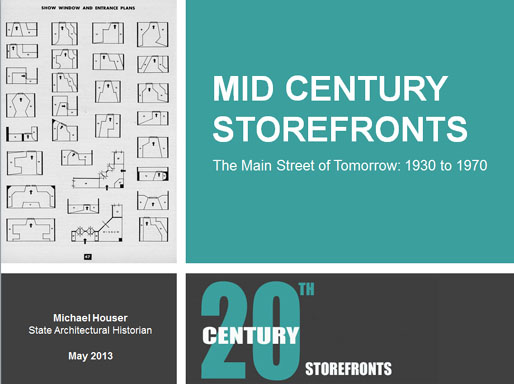Recent Past on Main Street
 Main Street changed dramatically in the mid-twentieth century as new buildings were constructed and older storefronts were remodeled to make them modern looking. In small towns and mid-sized cities across America, the first architectural expression of Modernism was often the bank, specialty shop, store, cinema, or pharmacy. Unfortunately, many of these “recent-past” resources are swiftly disappearing from our built environment, often before their importance is recognized. The preservation of smaller-scale, post-World-War II commercial downtown buildings is complicated by their both their familiarity and their incongruity. These historic resources from the 1940’s, 50’s and 60’s often go unrecognized by preservation efforts because they are just too “new” for many to recognize their cultural and historic significance. Furthermore, the sleek lines and smooth facades of post-war construction often contrasts sharply with the more traditional downtown buildings that preservationists warmly embrace. To further complicate the issue, new materials, technologies, and design assemblies of the mid-century often require new approaches to building repair and conservation. Yet these buildings reflect important developments in style, design, economics, and technology that resonated across a newly consumer-oriented America.
Main Street changed dramatically in the mid-twentieth century as new buildings were constructed and older storefronts were remodeled to make them modern looking. In small towns and mid-sized cities across America, the first architectural expression of Modernism was often the bank, specialty shop, store, cinema, or pharmacy. Unfortunately, many of these “recent-past” resources are swiftly disappearing from our built environment, often before their importance is recognized. The preservation of smaller-scale, post-World-War II commercial downtown buildings is complicated by their both their familiarity and their incongruity. These historic resources from the 1940’s, 50’s and 60’s often go unrecognized by preservation efforts because they are just too “new” for many to recognize their cultural and historic significance. Furthermore, the sleek lines and smooth facades of post-war construction often contrasts sharply with the more traditional downtown buildings that preservationists warmly embrace. To further complicate the issue, new materials, technologies, and design assemblies of the mid-century often require new approaches to building repair and conservation. Yet these buildings reflect important developments in style, design, economics, and technology that resonated across a newly consumer-oriented America.
Mid Century Storefronts: The Main Street of Tomorrow: 1930 to 1970
Overview of the design and application of mid century storefront systems, presented by Michael Houser, State Architectural Historian, at the Revitalize WA Conference in Vancouver, WA - May 2013.
WA State Guide to Modern Commercial Architecture: 1930-1975
Explore midcentury architecture of commerical buildings throughout Wasington. This guidebooks leads the reader through types and styles of resources built from 1930 to 1975, and highlights building materials and the architects who designed them.
Mid Century Period Storefront Publications
- Barrows Porcelain Enamel Co. Storefront - c. 1938
- Desco Copper Strontfront - 1935
- Himco Storefront - 1938
- Himco Storefront - 1946
- Kawneer Aluminum Storefront - 1960
- Kawneer - Zourtite Aluminum Facing - c.1958
- Libby Owens Ford Glass Co. "Glass in Architecture" - 1930
- Libby Owens Ford Glass Co. "How to Plan and Construct Modern Storefront" - 1936
- Pittsburgh Plate Glass Co. "How to Give Your Storefront the Look That Sells" - 1951
- Pittsburgh Plate Glass Co. "Product Accessories" - 1945
- Pittsburgh Plate Glass Co. Storefront - 1936
- Modern and Stricking Storefronts with Formica - c.1935
- Natcor Extruded Metal Storefronts - 1947
- Natcor Extruded Meta; Storefronts - 1949
- Porcelain Enamel in the Building Industry - 1953
- Plastics in Building - 1955
- The Design Potential of Metal Curtain Wall - 1960
- Metal Curtain Walls - 1955
- Zouri Storefront - 1935
- Zouri Storefont - 1937
- Acme Aluminum Storefronts - 1961
- Acme Aluminum Entrances - 1961
- Republic Steel Corporation - Enduro Stainless Steel - 1936
- GE Lighting for Show Windows - 1956






